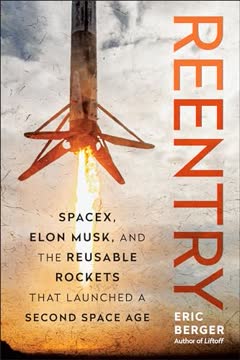Key Takeaways
1. Emerging technologies will revolutionize space exploration and resource utilization
If humanity gets cheap access to space, it's hard to imagine there will be no conflict over claims.
Space access is evolving. Reusable rockets, like those developed by SpaceX, could potentially reduce launch costs by 30-50% in the next two decades. Other innovative concepts include space elevators, electromagnetic railguns, and air-breathing rockets. These technologies aim to dramatically lower the cost of reaching orbit, currently around $10,000 per pound.
Asteroid mining presents opportunities. Near-Earth asteroids contain vast mineral resources, including metals like iron, nickel, and platinum. Mining these could provide materials for space construction and eventual return to Earth. Challenges include developing extraction techniques, navigation, and establishing space-based refineries. Companies like Deep Space Industries are actively pursuing asteroid mining technologies.
Potential asteroid resources:
- Water for fuel and life support
- Metals for construction
- Rare earth elements
2. Fusion power and programmable matter hold immense potential for energy and manufacturing
Cells are probably the best chemists there are.
Fusion power promises abundant energy. Nuclear fusion, which powers the sun, could provide nearly limitless clean energy on Earth. While significant technical challenges remain, projects like ITER aim to demonstrate the feasibility of fusion reactors. Successful fusion power could revolutionize energy production and enable long-distance space travel.
Programmable matter offers customization. This emerging field seeks to create materials that can change their physical properties on command. Applications range from shape-shifting furniture to self-repairing structures. Research areas include:
Approaches to programmable matter:
- 4D printing: Materials that change shape in response to stimuli
- Modular robotics: Small units that combine to form larger structures
- Claytronics: Tiny robots that can form 3D objects
3. Robotic construction and 3D printing will transform how we build structures
If you're trying to create a factory all at once, instead of building the structure, then bringing in machines, then hiring the employees.
Automated construction is advancing. Robotic systems are being developed to perform tasks like bricklaying, welding, and assembly. These technologies could increase construction speed, improve precision, and reduce costs. Examples include SAM (Semi-Automated Mason) and robotic arms for complex joinery.
3D printing enables new architectures. Large-scale 3D printing of buildings, using materials like concrete, allows for complex designs and rapid construction. Companies like Contour Crafting have demonstrated the ability to print house structures in 24 hours. This technology could revolutionize disaster relief housing and enable unique architectural forms.
Advantages of 3D printed construction:
- Rapid building times
- Reduced material waste
- Customization of designs
- Potential use of recycled materials
4. Augmented reality will enhance our perception and interaction with the world
If our brains were connected, you could experience something much more personal.
AR overlays digital information on reality. Unlike virtual reality, which replaces the real world, augmented reality adds to it. This technology has applications in education, entertainment, navigation, and professional fields like medicine and engineering. Challenges include precise tracking of the user's environment and creating convincing integration of virtual elements.
Medical and industrial applications are emerging. Surgeons can use AR to overlay patient data and imaging directly onto their field of view during procedures. In manufacturing, AR can provide workers with real-time instructions and safety information. As the technology improves, it may fundamentally change how we interact with information and our environment.
Potential AR applications:
- Enhanced navigation and travel experiences
- Interactive educational exhibits
- Improved collaboration in remote work
- Personalized advertising and shopping experiences
5. Synthetic biology enables custom-designed organisms and medical breakthroughs
Using less propellant is a little trickier, even though propellant is 80% of a spacecraft's starting mass.
Genetic engineering is advancing rapidly. Tools like CRISPR-Cas9 allow precise editing of DNA, enabling the creation of organisms with desired traits. This technology has applications in agriculture, medicine, and industrial production. Researchers have already created bacteria that can produce medicines and materials not found in nature.
Medical applications show promise. Synthetic biology techniques are being used to develop new treatments for genetic disorders and cancer. Gene therapies could potentially cure previously untreatable conditions. Other applications include:
Synthetic biology breakthroughs:
- Bacteria engineered to produce artemisinin (malaria treatment)
- Yeast modified to create opioid precursors
- Engineered immune cells (CAR-T) to fight cancer
- Gene drives to combat mosquito-borne diseases
6. Precision medicine tailors treatments to individual genetic profiles
Everything That's Wrong with You In Particular—a Statistical Approach
Personalized treatments are becoming possible. By analyzing an individual's genetic makeup, doctors can predict disease susceptibility and drug responses. This allows for more targeted and effective treatments. Technologies like liquid biopsies, which detect cancer DNA in blood, enable early diagnosis and monitoring of diseases.
Big data and AI enhance medical analysis. The integration of large-scale genomic data with medical records and environmental information allows for more accurate predictions and treatment plans. Challenges include data privacy concerns and the need for more diverse genetic databases to ensure equitable benefits across populations.
Components of precision medicine:
- Genetic sequencing and analysis
- Biomarker identification
- Targeted drug development
- AI-assisted diagnosis and treatment planning
7. Brain-computer interfaces may augment human cognitive abilities
You get a rod put in your brain, and the rod has a battery-powered electrode at its tip.
Direct neural interfaces are developing. Technologies like deep brain stimulation are already used to treat conditions like Parkinson's disease. Future BCIs may allow direct control of computers and prosthetics, or even enhance memory and cognitive function. Ethical concerns include privacy, identity, and potential social inequality.
Non-invasive technologies show promise. Techniques like transcranial magnetic stimulation (TMS) can modulate brain activity without surgery. These may lead to treatments for depression, anxiety, and other mental health conditions. Consumer-grade EEG devices are also emerging, allowing basic brain-computer interaction for games and meditation aids.
Potential BCI applications:
- Restoring movement to paralyzed individuals
- Enhancing memory and learning
- Direct brain-to-brain communication
- Controlling external devices with thought
8. Ethical considerations and unintended consequences accompany technological progress
A device for solving math and physics problems that could, by the mere virtue of its existence, have implications for our understanding of the entire cosmos?
Technological advances raise ethical questions. Issues of privacy, inequality, and unintended consequences must be addressed as these technologies develop. For example, genetic engineering capabilities raise concerns about "designer babies" and potential misuse of the technology.
Societal impacts must be considered. The widespread adoption of technologies like AI and automation may lead to significant job displacement. Ensuring equitable access to the benefits of new technologies, while mitigating potential harm, will be crucial. Additionally, the environmental impacts of new technologies must be carefully evaluated.
Ethical considerations in emerging technologies:
- Data privacy and security
- Equitable access to benefits
- Potential for misuse or weaponization
- Long-term environmental impacts
- Unintended societal consequences
Last updated:
FAQ
What's Soonish about?
- Exploration of Technologies: Soonish by Kelly and Zach Weinersmith explores ten emerging technologies that could significantly impact our lives, either positively or negatively.
- Humor and Insight: The book combines humor with scientific insight, making complex topics accessible and engaging for readers.
- Future Predictions: It discusses potential future applications and the uncertainty inherent in technological advancement.
Why should I read Soonish?
- Engaging Writing Style: The authors use a conversational tone filled with wit, making the book enjoyable and easy to read.
- Broad Range of Topics: It covers a variety of technologies, appealing to readers with different interests in science and technology.
- Critical Thinking: The book encourages readers to think critically about the implications of emerging technologies.
What are the key takeaways of Soonish?
- Technological Uncertainty: Predicting the future of technology is incredibly difficult, emphasizing the complexity of advancements.
- Interconnectedness of Innovations: Many technologies depend on advancements in other fields, highlighting the complexity of technological development.
- Potential for Good and Bad: Each technology discussed has the potential to improve lives or create new problems.
What are the best quotes from Soonish and what do they mean?
- “Predicting the future accurately is hard. Really hard.”: Highlights the uncertainty in forecasting technological advancements.
- “If we could make the launch vehicle recoverable, you could potentially eliminate 90% of the cost of space launch.”: Emphasizes the potential for reusable rockets to revolutionize the space industry.
- “The path out of the solar system may run through its junkyard.”: Reflects the idea that utilizing resources from asteroids could be key to future space exploration.
What is the significance of asteroid mining in Soonish?
- Resource Availability: Asteroid mining could provide access to vast resources, essential for space colonization.
- Cost-Effectiveness: Mining asteroids may be more cost-effective than transporting materials from Earth.
- Foundation for Space Settlements: It is crucial for establishing long-term human presence in space by utilizing local resources.
How does Soonish address the challenges of fusion power?
- Energy Source Potential: Fusion power is presented as a clean and virtually limitless energy source.
- Technical Hurdles: Significant technical challenges remain before fusion can be harnessed for practical use.
- Current Research: Ongoing projects like ITER and NIF aim to make fusion a reality, though practical use is still distant.
What is programmable matter, as described in Soonish?
- Definition and Concept: Programmable matter refers to materials that can change shape and properties based on input.
- Applications: Potential applications include furniture that transforms or tools that adapt to tasks.
- Current Research: Ongoing research at institutions like MIT focuses on creating responsive materials.
What are the implications of brain-computer interfaces discussed in Soonish?
- Direct Communication: BCIs could allow direct communication between the brain and devices, aiding those with disabilities.
- Memory and Cognition: BCIs might enhance or alter human memory and cognition.
- Ethical Considerations: The authors caution about privacy concerns and potential misuse of BCIs.
How does Soonish explore the concept of augmented reality?
- Definition and Functionality: AR overlays digital information onto the real world, enhancing perception.
- Applications in Various Fields: Potential applications include education, medicine, and entertainment.
- Challenges and Future Directions: Technical challenges include achieving seamless AR experiences.
What are the potential benefits of robotic construction as outlined in Soonish?
- Efficiency and Speed: Robotic construction could significantly speed up building processes.
- Cost Reduction: Automation could lower costs, making housing more affordable.
- Customization and Quality: Allows for greater customization in building designs.
How does Soonish address environmental concerns?
- Sustainable Energy Solutions: Discusses biofuels and renewable energy sources to mitigate climate change.
- Impact of Synthetic Biology: Highlights contributions to environmental monitoring and remediation.
- Caution Against Invasive Species: Warns about risks of releasing synthetic organisms into the environment.
What ethical considerations are raised in Soonish?
- Genetic Engineering: Raises questions about the morality of genetic modifications in organisms.
- Privacy and Surveillance: Discusses potential privacy invasions by brain-computer interfaces.
- Access to Technology: Highlights concerns about unequal access to emerging technologies.
Review Summary
Soonish explores emerging technologies with humor and science. Readers appreciate the accessible explanations and witty comics, finding it informative and entertaining. Some praise the balanced approach to potential risks and benefits. Critics note outdated information and juvenile humor. The book covers topics like space exploration, fusion power, and bioprinting. While some find it too simplistic, others enjoy the lighthearted approach to complex subjects. Overall, it's viewed as a fun introduction to future technologies, though opinions on the humor vary.
Similar Books






Download PDF
Download EPUB
.epub digital book format is ideal for reading ebooks on phones, tablets, and e-readers.




